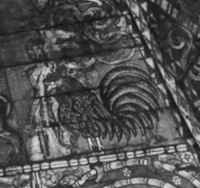 |
|
|
[Page 105]
Gwoździec Wooden Synagogue, Alois Breyer
Tel Aviv Museum of Art
Gift of Alois Breyer, Baden bei Wien, 1937
Archival Photographs: Avraham Hai
With many thanks to Yaffa Goldfinger and Emanuela Calo
Tel Aviv Museum of Art
|
|
|
|
|
|
[Page 106]
|
|
20. “Brich Shme Demare Alma…” On the right is the prayer in Aramaic (which is said when opening the Ark to take out a Torah scroll): “Brich Shme Demare Alma…” (Zohar Parashat Va'ikhael, 70, 369), donated by Yaakov … (and in the middle) Yitzchak Chaim in honor of his son Kopel, 1728, Bar Dov, 1640.
|
[Page 107]
|
|
Coordinator's note: From the Jablanov Wooden Synagogue |
|
|
22. “Al Hakol Itgadal…”. On the left is the prayer, which is also said at the time of opening the Ark to taking out a Torah scroll (Tract of Scribes, 14, halacha 12), “Al Hakol Itgadal Ve'itkadash Ve'ishtabach” (for everything shall be sanctified and magnified and praised…)”. Donated by the bigwig Shimon Halevi Yitzhak Ben Shimon, in honor of his young son Shimon 1728. The first word “Al”, is given within a decorated medallion, and it is supported by lions on either side. Above the frame is a painting of a crown. From the ceiling hangs an antique chandelier, - an antique candelabra - with deer-like candlestick wings emerging from its center. On the right is the inscription (Psalms 5, 8), “And I will come to your house in the abundance of your grace…”. |
[Page 108]
|
|
|
[Page 109]
|
|
24. The north wall with a window. The window is blocked by wood planks, they probably added a room behind it. Next to it is an inscription (not visible in the picture) from the prayer of plea (Tachnun), which was donated by Issachar Bar Ben Yitzchak to his firstborn son Yehuda Leib, as well as the verse (Deuteronomy, 33, 18): “And to Zebulun he said, rejoice, Zebulun, in your going away, and Issachar stays in your tents”. The quote is here because the name Issachar is mentioned in it. |
[Page 110]
|
|
25. General appearance of the stage. The stage stands in the center of the great hall, it has eight pillars and above it, in the center, rises a tiny stage-like lantern on top of eight thin and wavy arches that each come out above the tops of the stage pillars and connect to the lantern house above them. The structure gives the stage the shape of a crown-canopy - out of respect for the Torah. Worthy of attention are the connections in the middle of the arches. Everything is made of carved wood. Inside the stage there are three inscriptions referring to the reading of the Torah:
|
[Page 111]
|
|
26. The upper part of the stage, (a): Fruits and leaves. The artist symmetrically developed the motif of fruits and leaves. Above each pillar there is a rose (rosette). Everything is carved in the wood. |
|
[Page 112]
|
|
27. The upper part of the stage (b): Deer. The artist carved figures of the deer here in wood, he designed two deer in a geometric form facing each other in a sort of position of floating in the air after the jump. The realistic anatomical proportions prove that the artist was well acquainted with such animals. Stylish flowers balance the tangle of their horns and that too in a symmetrical way. Here, the work of carving the wood above the lantern can be seen. This “onion-shaped” cupola (dome) is reminiscent of the Russian-style cupolas. |
[Page 113]
|
|
28. The upper part of the stage (c): Lions. A pair of lions stand facing each other in a pre-jumping position. The artist wanted to highlight the animal's power and its strength by emphasizing the massive and stylish mane, the tail raised in a rounded and elegant way equates it with a realism of movement. The design is symmetrical, the work is done in wood carving. |
[Page 114]
|
|
The drawings on the triangles: 29. The triangle in the southeast corner (a). A painting of the verse (Psalms 25, 53): “Cast all your troubles on God…”, inside one of the four triangles that form the octagonal opening of the dome, whose role is to serve as a connection between the curves. All of these constitute the first curved floor of the dome complex, and rising from the four walls of the central hall. Below the prayer, which is placed in a trapezoidal frame, there is a painting of a fearsome bull with enormous horns. The bull lying down under him. The artist drew the bull's head and horns symmetrically. The dimensions of its body were drawn in a realistic manner that preserves the anatomical proportions well. Above, to the right, there is the “signature” of the painter within a double-round frame: “By the workman engaged in the sacred craft. The elder painter Yisrael, the son of Rabbi Mordechai Shen of Yartsov, the province of the holy congregation of Lvov”. |
[Page 115]
|
|
|
|
|
|
|
JewishGen, Inc. makes no representations regarding the accuracy of
the translation. The reader may wish to refer to the original material
for verification.
JewishGen is not responsible for inaccuracies or omissions in the original work and cannot rewrite or edit the text to correct inaccuracies and/or omissions.
Our mission is to produce a translation of the original work and we cannot verify the accuracy of statements or alter facts cited.
 Hvizdets, Ukraine
Hvizdets, Ukraine
 Yizkor Book Project
Yizkor Book Project
 JewishGen Home Page
JewishGen Home Page
Copyright © 1999-2025 by JewishGen, Inc.
Updated 12 Oct 2025 by LA